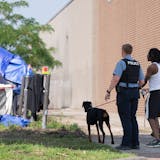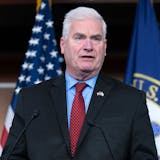On the last Friday in September, before a capacity crowd, Sauk Centre's football team played on the school's new field -- becoming one of the state's smallest schools to move to artificial turf.
"We do budget cuts every year and it hurts, [and] I'm going to spend how much money on an artificial field?" said school board chair Ann Mitchell, who agonized over her vote, but finally backed the new field as part of a $2 million sports facilities upgrade.
By the end of this year, the FieldTurf company -- which has installed the playing or practice fields for 21 of the National Football League's 32 teams -- will have installed its 60th artificial turf field at colleges and high schools in Minnesota, many at public schools where budget woes for education are a daily fact of life. Many schools, after wincing at the initial costs, are opting for the fields and arguing that the artificial surfaces can better absorb bad weather and allow multiple sports and even gym classes to use them daily without noticeable wear and tear.
The trend is continuing even as leading experts such as John Sorochan, co-director of the Center for Athletic Field Safety at the University of Tennessee, caution that artificial turf has not been shown to be cheaper over time and others say that heavy use of the fields shortens their life span. Brad Fresenburg, a turf-grass specialist at the University of Missouri, said some officials are simply eyeing rival schools and making the purchase to "keep up with the Joneses."
"I always laugh at how [financially] strapped schools can all of a sudden come up with $600,000 to $1 million" for an artificial turf field, said Sorochan, whose field safety center is funded in part by an artificial turf company. He acknowledged there is a "time and a place" for artificial turf fields, especially at schools where multiple sports must share limited space and "you just can't keep grass alive."
But too many schools, Sorochan said, are creating reasons to justify the expense.
Not everyone agrees, of course. "In this day and age, there's critics of everything," said Dan Brooks, the Sauk Centre district's superintendent, in defending the artificial turf decision. "Like it or not, school districts are businesses" competing for students and "you need to be competitive." Even the girls' volleyball team, added one school official, has used the new field for conditioning.
Wear and tear factor

